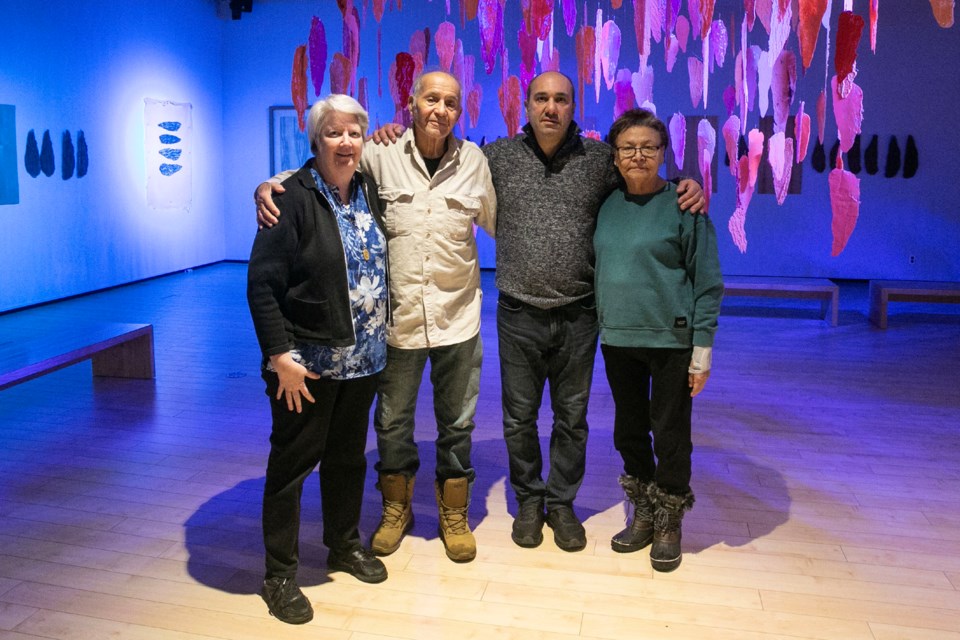An exhibit currently at the local art gallery uses diverse storytelling and sculptures to tell the story of the area before and during the time of European contact with local First Nations, with the intent of helping people process Truth and Reconciliation.
Confluence celebrated its opening at the Art Gallery of Algoma on Nov. 1 with hundreds in attendance.
Adriano DiCerbo is a St. Mary's College arts teacher who spearheaded the project along with Sister Mary Jo Radey, Noel “Skip” Jones, and Barbara Nolan. The project took years to assemble and includes interviews with storytellers that bring the different motifs in the space alive through words and experiences.
The exhibit is the second facet of the project, with the first being a school exhibit at the chapel in St. Mary's College titled 'The Healing Space.'
DiCerbo and Radey come from European backgrounds, while Jones and Nolan bring their Indigenous perspectives to the exhibit. The exhibit takes those diverse worldviews to examine the importance of land and water and the inter-connectedness people have with Earth and to each other.
Confluence uses a number of motifs woven together to tell its story, including recurring circles, life-size moulded sculptures of the Eastern White Pine and life-size moulded sculptures of filleted whitefish. A video of the four storytellers involved in the exhibit plays on a loop, eventually taking up the four sides of the space, evoking the four parts of the Medicine Wheel.
In one part of the exhibit, dozens of pink whitefish fillet sculptures hang together from the ceiling, representing the importance of fish to the Indigenous people of the area in the time before European contact.
Jones said archaeological digs have linked fish bones from this area to places thousands of kilometres away — suggesting the area where whitefish were traded far and wide by the Indigenous people of the day.
"They would come here to smoke and dry the fish for the winter. So this was always a big meeting place," said Jones.
The initial inspiration for the project came from the news coming out of the Truth and Reconciliation Commission in 2015 and the conversations it sparked between himself and Jones at the time about how to use art to help address some of the issues raised in the report, DiCerbo said.
"I think people want to do something [about Truth and Reconciliation], they're just not sure about how. I think this is giving people an opportunity to be part of that journey of healing in a capacity that they can contribute," said DiCerbo.
"At the end of our conversations, Skip sort of gave the projects this breath of life by saying, 'I believe this has been magnificent' and that really has stayed with me," said DiCerbo.
In 2015, the pair went into the wilderness to harvest some Eastern White Pine to be cast as a test for one of the sculptures in the exhibit. One wall of the exhibit space features a small forest of the sculptured trees to help in telling the story.
As the project started to come together, Nolan was brought on to add her storytelling perspectives — some of which are shared by video in Anishinaabemowin. She spent four years of her childhood in the Residential School system.
"When I got home I had to relearn compassion, I had to relearn love, I had to relearn everything that I lost over there," she said. "I've learned to forgive and I think in that I'm at peace. Now that's why I'm doing everything I can to help the people who haven't got there yet."
Jones said Nolan's reputation as a storyteller, especially through Anishinaabemowin, is well deserved.
"She won't tell you this, but she is one of the best storytellers and recognized as the best in passing on the language," he said.
Radey, a nun from chapel at St. Mary's College, was the final storyteller piece added to the puzzle. She was initially reluctant to add her voice to the project, but eventually came around to participating after speaking to the other storytellers and considering that the mission of her congregation is unity and reconciliation.
"The world is wounded, Canada is in need of healing. This unspoken wound of how Indigenous people have been treated — as Skip and Barbara talked about — we don't acknowledge it well in Canada," Radey said.
Confluence runs until Jan. 11 at the Art Gallery of Algoma.
